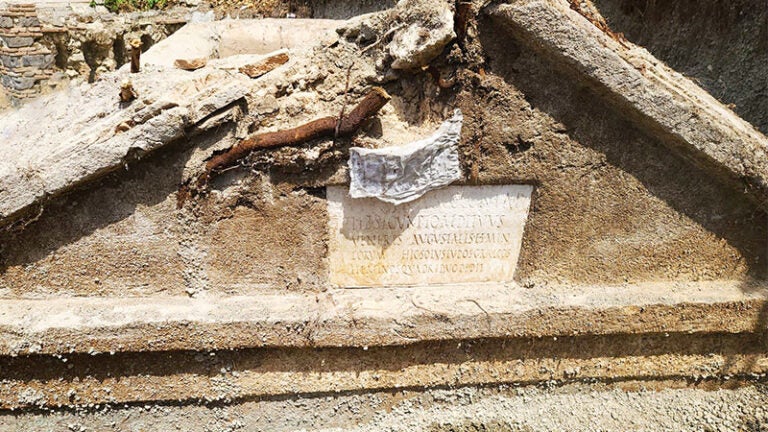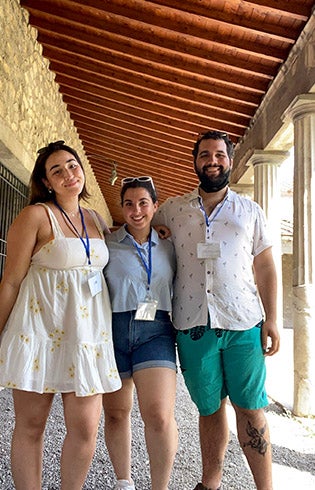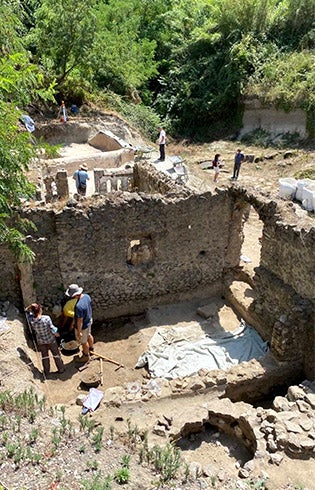
USC students uncover well-preserved skeleton in the ancient city of Pompeii
The big picture:
- Three USC students helped excavate the partially mummified body of Marcus Venerius Secundio, a former slave and priest who lived and died in Pompeii before the eruption of Mount Vesuvius.
- An inscription on the tomb indicates Secundio produced plays in Greek, the first concrete evidence that the language was used theatrically in a city that spoke primarily Latin.
- The students also helped excavate urns containing cremated human remains, likely members of Secundio’s family.
Undergraduate students from the USC Dornsife College of Letters, Arts and Sciences helped excavate one of the most well-preserved sets of human remains ever discovered in the ancient city of Pompeii, Italy.
The partially mummified skeleton of Marcus Venerius Secundio, a former slave and priest, still possesses wisps of white hair and the remains of an earlobe.
Most Roman adults were cremated, so finding skeletal remains is uncommon, and Secundio’s body was unusually well-preserved for its age. Researchers are still determining if there was any intentional effort to mummify the corpse.
Buried outside Secundio’s tomb were several urns containing ashes, likely members of his family. Luis Rodriguez-Perez, an archaeology major, and Sabrina Dimesa, an economics major, helped bring one of the urns into the light for the first time in nearly 2,000 years.
“After the site director pulled it out of the ground, opened it and saw we had human remains, he let me carry it to the car,” Rodriquez-Perez says. “I walked it all the way from the site. Knowing I had a whole person in there, with a story and a life, that they were in my hands — it was surreal. There’s a cognitive dissonance in disturbing their final resting place and bringing this new material into the modern public sphere of knowledge.”
Trojans in Rome

From left: Sabrina Dimesa, Lauren Malkoun and Luis Rodriguez-Perez.
Secundio’s tomb was located in the Porta Sarno Necropolis, where many of the city’s dead were buried. It’s a rich site for learning about Roman burial practices. The University of Valencia, through a program called The Archaeology of Death in Pompeii at Porta Sarno Necropolis, manages excavation in the area.
Rodriguez-Perez, Dimesa and Lauren Malkoun, an archeology major, joined the excavation team through the organization Archaeospain, which pairs students with ongoing archaeological expeditions.
The three stayed in the neighboring town of Marra and commuted to the dig site every day. When they weren’t lugging wheelbarrows of volcanic rock or sifting dirt for artifacts, the three embarked on day trips to places like Naples or Paestum, a Greek settlement with striking Doric temples.
For Malkoun, a sophomore whose first year at USC was entirely online due to the COVID-19 pandemic, it was a welcome return to communal study.
“My favorite memory from the summer was getting to meet members of the Trojan Family in person,” says Malkoun, who is the vice-president of USC’s Society for Trojan Archaeologists.
Graveside morality
The dig was not without its challenges. Securing funding to conduct archeological work overseas was the first obstacle.
“My trip was only possible thanks to people like Lynn Dodd [associate professor of the practice of religion and spatial sciences], who is always sending me funding opportunities and writing recommendation letters for me.” says Rodriguez-Perez, a senior who plans to pursue a Ph.D. in archeology after graduation.
Malkoun found travel support in both the prestigious Undergraduate Fieldwork Scholarship from the Archaeological Institute of America, Los Angeles Society and a second competitive award from the American Society of Overseas Research, which supported her work on another project.

Students sifted through layers of sediment looking for clues about how life was lived in ancient Pompeii.
All three students grappled with the morality of excavating a gravesite. Although there’s much to be learned historically from these types of digs, it also comes with the price of disrupting human remains.
“Coming into these sacred spaces as archaeologists requires an understanding of cultural practices and also the duty to respect the rituals of these spaces,” says Dimesa. Hopefully, they say, future funerary archeology will rely less on disturbing graves. One new method, photogrammetry, uses hundreds of photos to assemble a 3D model of an artifact. Researchers can then study the object virtually, without having to move it from its original site.
There were also physical demands to contend with: The three students spent weeks under the blistering Italian sun shoveling layers of accumulated stones and sediment that covered excavation sites.
Discoveries worth the sweat
Secundio’s grave is significant not just for his excellent physical preservation but also for what the tombstone tells us about his life. According to the grave’s inscription, in addition to his work as a priest in a religious group dedicated to Emperor Augustus, Secundio also conducted plays in Greek.
This was a particularly exciting discovery for scholars, who say it is the first concrete evidence that the language was used theatrically in the city where most residents spoke Latin.
“That performances in Greek were organized is evidence of the lively and open cultural climate which characterized ancient Pompeii,” says Gabriel Zuchtriegel, director of the Archaeological Park of Pompeii, in a press release.
The remains are currently under analysis at the Laboratory of Applied Research in Pompeii, where researchers are also determining how to preserve them.
The find of a lifetime
For Rodriguez-Perez, all the work of his undergraduate degree was put to test this summer when he excavated that urn of ashes outside Secundio’s tomb. As he dug one afternoon in late July, a clump of burnt material beneath the soil signaled that he was likely on the right path to discovery.
“Romans would burn offerings near a grave, and a lot of charcoal had meshed with the soil. I knew before I even got down [to the urn] that I was going to find something incredible,” says Rodriguez-Perez.
As he dug, he reflected on the past three years of study and training at USC Dornsife. “It made me think about all the things I had done to get there, all my work at the USC Archaeology Research Center, the digs I’d done beforehand,” says Rodriquez-Perez. “Because this could definitely be the coolest thing I might ever excavate.”